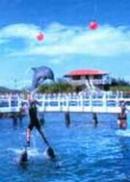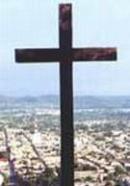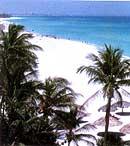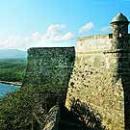Travel ChroniclesLike pouring sand into the hourglass
My plane touches down the runway of Havana's Jose Marti International Airport in the evening. I'm setting out to do quite a deed: tour four Cuban provinces in just eight days and get the best of the island nation, so every minute counts. I hop in a taxi and explain to the cabdriver my desire to watch the 9 o'clock cannon shot ceremony at the San Carlos de la Cabaña Fortress. Kind and friendly –as most Cubans are- he nods his head. The ceremony is amazingly solemn, accurate and gaudy. It strikes my attention to see how well preserved these old and anecdote-riddled military fortresses really are. On my way to the hotel, the taxi driver acts like a timely guide and tells me those facilities have become cultural centers to house the different arts.
Around 10:00pm, I walk into the Ambos Mundos (Both Worlds) Hotel. I chose it for its location in Old Havana where I intend to take a spin around in the morning. It's an old hotel, yet it's been refurbished and outfitted with all conveniences. This place trimming with history and legends, was well-known American writer Ernest Hemingway's hotel of choice for years. Some say he wrote some of his great novels here. I'll try to take a look at his room, preserved like a relic, and find out if a part of his wandering spirit could help me fill out the blanks in this travel chronicle of sorts.
First day in Havana Daybreak reveals a clear and sunny day; weather is great for taking a stroll. My mind is set on the Cathedral Square. Even though it's early, the place is already bustling. I pace quietly down the cobblestone street to the façade of the eye-opening cathedral. I take a few snapshots. Inside, the church is equally majestic with its gorgeous Chapel of Our Lady of Loreto and other attractions that lure arts buffs and culture-vultures.
I step back on the square and realize this is a land of contrasts. A black fortuneteller, tricked out with necklaces and other attributes, reads the fate of locals and foreigners alike. She foretells me a happy trip and a soon return to the island, drawn by bigger and mightier feelings. Love? Business? Only time will tell. I take a few minutes to glance at the assortment of craftsmanship offered by street peddlers, a typical attraction around here.
My camera starts clicking again in the face of the breathtaking colonial-style buildings hedging the square. I zoom in on the Museum of Colonial Art, former residence of the Counts of Casa Bayona, and on the peculiar edifice that today houses the El Patio Restaurant. A few yards away from the square, I happen on an architectural gem of marked baroque influence and neoclassical elements: the mansion that now hosts the Alejo Carpentier Foundation. The Cuban novelist used this building as the setting for his work The Century of Lights. Not far from there, I have the chance of guzzling one of those famous mojitos at the Bodeguita del Medio. I would certainly need more time to read all the anecdotes scribbled on its walls. But this has been quite a refreshing pause in the tour, anyway.
Curiosity leads me to the Water House, a picture-perfect place brimming with legends where passer-bys can drink some water absolutely free. I saunter to the quarters of the Old Havana Scale Model, a magnificent miniature work that allows visitors to take a bird's-eye peek of the old city and have a more precise orientation for the remainder of the hike.
My next stop is the Arms Square, a plaza hemmed in by such major buildings as the Palace of the Second-in-Command, one of those colonial-style constructions of astonishing beauty: inner patio, staircases, internal decoration. The edifice now headquarters Cuba's Book Institute. Once again, I give myself away as a shutterbug. Other majestic building in the surroundings are the Palace of Captain-Generals –currently the Museum of the City- the new and luxurious Santa Isabel Hotel, and the Small Temple, a symbol of the capital's foundation with its emblematic ceiba tree where people mark Havana's anniversary every year in a mixture of magic and history.
It's almost two in the afternoon and I jump on a funny coco taxi, an egg-shaped three-wheeler that weaves its way to the store-packed Obispo Boulevard. There're clear indications of an attempt to rescue the area's former commercial lust. Right on the corner of the boulevard, I chance upon the Floridita Restaurant. Up to here, the grand tour has been fascinating. The tropical breeze has whetted my appetite. Besides, the food here is as superb as the unmatched diquiri cocktail that Hemingway put on the map. Before the barstool where the famous U.S. writer used to sit on –lovely preserved by the restaurant's patrons- I recall the anecdotes I've heard about his frequent visits to the eatery.
I amble out of the restaurant and flag down a traditional horse-drawn buggy full of festoons and steered by a uniformed coachman, just like in the old days of colonial Havana. The carriage is taking me to a place where I'm about to kick off a new adventure. I'll take the motorboat that ferries people across the bay all the way to Casa Blanca. I want to take a closer peek at Havana's Christ. This is an amazing statue, not only for its height and beauty, but also for the location from where Jesus seems to stare protectively at a considerable chunk of the city. I take the boat back to the other side of the bay as the night closes in. I wave the Christ good bye, now glowing magnificently as spotlights light him from the base up.
After dinner and a short break in the hotel, I must pick a place to know Havana's nightlife. It's Thursday and the island nation's top salsa acts are scheduled to perform at the Macumba ballroom. I take a cab, of course, because the nightclub is in a neighborhood in the outskirts of town called La Coronela. The night seems so short listening to salsa music and enjoying the good atmosphere there.
Second Day The sun goes up on my second day in Cuba. The night at the Macumba was one for the books. Today, I'm setting out to know other zones of Havana. My trip tees off in Miramar. After a good breakfast at the hotel, my taxi takes me to well-known 5th Avenue. This is a residential neighborhood where most of the embassies to the country are located. Besides the tackiness of mansions, buildings and restaurants, abundant green landscaping breathing life into the burg really meets the eye.
On my way back and after crossing a short tunnel connecting Miramar to the rest of the city, I make a brief stopover at the Colon Cemetery to delve into Cuba's funerary tradition. Some of the mortuary monuments here are exquisite works of art. There are graves peppered with fantastic legends and tombstones that lay bare this people's jauntiness even in the face of death.
Back in the cab, I head to downtown Havana to a pay a visit to the Hammel Alley, a small cul-de-sac turned into an unusual mural of African-Cuban culture. Its originality quenches my wondering why this is one of the most sought-after spots in town by tourists, just like me, intended to capture the charms of this island nation in just a few days.
My feet take me to the Museum of the Revolution in the former Presidential Palace, and from there to the Capitol. Its outer structure is similar to others in America. Its interiors, however, shelter a peerless sample of art and grandeur really hard to describe. I walk past the Revolution Square with its gigantic monument to Jose Marti and a history of its own. It's lunchtime, so I drive back to Old Havana and land pretty near the Cathedral. El Patio Restaurant –housed in a splendid 18th-century mansion and featuring a central patio dominated by a fountain and wrought-iron balconies- panned out to be pretty intimate. No doubt this has been a wise pick both for the ambiance and the food.
My program continues with a call to the National Museum of Fine Arts, startling from the very façade, but I'm running out of time to take a grand tour around today. I stride on to the most crowded part of the Vedado area: the corner of La Rampa and 23rd Avenue, with its “treading museum,” an assortment of round slabs ingrained in the sidewalks that depict the works of famed Cuban artists. I make up my mind to stick around and have something to eat. I'm also eager to catch up on a part of Cuba's many-sided culture. The Fox and The Raven suits me down to the ground. But I can't stay up tonight because I'll be off tomorrow first thing in the morning.
A Paradise of Sun and Beach It's 8:30am and I'm on my way in a cab I rented at the hotel. I see the capital off to meet Varadero, some 87 miles away. An hour later I'm in Matanzas, a city nicknamed here The Athens of Cuba and The City of Bridges. The latter is true since you hit the entrance. I stop briefly and shuffle into the Pharmaceutical Museum –the only one of its kind in the world- the Cathedral, the Sauto Theater –famous for its extraordinary acoustics- and the Plaza de la Vigia, a foundational center where several cultural institutions are headquartered.
As I drive out of town, I take another look at this city that resembles a huge amphitheater that's been perched around the gorgeous bay. Its dwellers, proud of the burg's natural beauties, history and culture, present it to me full of poetry.
The sweltering sun is beating down when I get to Varadero some twenty minutes later. My stomach lets me know that noon is near. I drop in on a picturesque place called La Esquina Cuba. This is a peculiarly decorated place serving the best Cuban food money can buy.
I head to the hotel to check in for a night since my stay will be brief. I choose the Meliá Varadero, one I've heard the best references about, and unpacking just my swimwear and a fresh cotton shirt, I pace my way to the Josone Park, a place where nature, buildings and the general environment keep your camera clicking time and time again.
On with my tight schedule, I climb to the Xanadu Mansion. From the road, I make out the golf course, penciled in as one of the finest in the Caribbean. The beauty of what you see really packs a wallop to your senses, but time doesn't allow me to see firsthand the good technical qualities this place is famous for. The Xanadu Mansion –former residence of millionaire Irenee Dupont de Nemours and currently housing the Varadero Golf Club– is a majestic construction featuring an interior decoration excellently well preserved.
Sunset is close at hand and that's for sure one of the best times of the day for taking a swim at the beach. It's a sin to pass by Varadero without diving into the sea. As a matter of fact, these are miles of crystal-clear waters and white sands we're talking about, an offer you just can't refuse.
I come back to the hotel and decide not to go out tonight. I can watch a nightly show at the Meliá and wake up early in the morning to make a beeline for the airport to start out the second part of my frenzied adventure: Santiago de Cuba and Holguin.
I'll go to Santiago This promises to be an equally splendid and action-packed day. I've got my mind made up to see eastern Cuba and I'm as excited as I can possibly be for I've been described an earthly paradise. I pack up again, ride a cab to the Aerocaribbean airport in Wajay and take the first flight to Santiago de Cuba.
Flying out of Havana, I watch the capital again from the air. The pilot's voice informs through the speakers that we're 23,000 feet high, way over a blanket of white clouds I can make out under the wings of the plane.
There are some 500 miles between both cities. A hour and a half later, almost at noon, I set both my feet on Santiago de Cuba, the Sweltering Land, the Land of Son. As the plane readies to land, I see a shocking mountain range dominated by the Sierra Maestra National Park and its 17 peaks, all of them over 1,300 meters high. The Turquino Peak –Cuba's highest mountain with 1,974 meters above sea level- takes the cake here.
I can almost touch the mountains of El Cobre Sanctuary, a mythical and spiritual getaway presided over by Cuba's saint patron, the Virgin of Charity, crowned by Pope John Paul II.
At the Antonio Maceo International Airport, I quickly get acquainted with a cab driver who steers me to the Hero City. Among an array of hotels to choose from, I take the Casa Granda, across from Cespedes Park and right in the throbbing heart of Santiago's restless cultural life.
I take a panoramic view of the Colonial City, the bay, the surrounding mountains, the Cespedes Park and the oldest buildings in town, like the monumental Cathedral that showcases the island nation's first-ever painting –an artistic board carved in times of the ecce homo. Temps appear to be on the rise with each passing minute. People, though, walk past me with smiles on their faces.
A two-hour hike around Santiago has been good enough to peek at the oldest house in the Americas, the Municipal Palace with floor-through balconies and parquet ceilings, the Governor's Mansion –now serving as the Museum of Furniture- and the Velazquez's Balcony, where residents, as I was told, set up a dais for president Fidel Castro's first speech to the Cuban people in 1959.
I saunter down Aguilera Street in search of other sites and I get to the Bacardi Museum, a place full of historic and artistic glamour. A little bit further, I stop at the Dolores Plaza, stunned by an array of residential balconied buildings that take up this portion of the burg.
I make a necessary pause to have something to eat and I get a welcoming cocktail at the Casa de Don Antonio. I try some Cuban food: congri oriental, seasoned cassava and roast pork meat washed down with an icy Hatuey beer, Santiago's typical lager. Honestly speaking, the food couldn't be any tastier.
I feel like as snug as a bug in a rug and on my way back to the hotel I stroll the city all the way around down Heredia Street, the most famous and bustling of all, from Calvario to San Pedro. Up and down that narrow avenue, both pedestrians and cars seem to elbow their way through. What an amazing sight this is! Everybody appears to have the same crossing rights, but the point is that vehicles actually slow down to make it through the swarm of people. I walk into poet Jose Maria Heredia's well-preserved birthplace house and I flip over the memories of the romantic author of Ode to the Niagara.
At the House of the Troubadour, my visit takes longer than expected. Through its wrought-iron gates, I can see people dancing graciously to the beat of the drums and the strumming guitars.
Farewell, Santiago Yesterday I made arrangements with Cubanacan Travel Agency to bus my way up to Holguin. Departure time is 4:00 o'clock this afternoon from Cespedes Park. I've already booked a room somewhere in Guardalavaca Beach. That's perfect, so I could see some more about Santiago before my bus leaves.
I take a cab ride to cover the dozen miles spanning the city and the El Cobre Sanctuary. A few minutes later, I'm on top of that same mountain I'd made out from the aircraft. It's as early as 8 o'clock in the morning, and Mass is already in full swing in the church.
I've taken some pictures of the place and its surroundings, even a few snapshots of Cuba's saint patron surrounded by attributes and relics people have been laying there for years.
I stay a little longer than an hour in El Cobre and breathe the mild breeze blowing through the mountains. I hop back in the taxi and head to Baconao, considered the lung of this hot city. Right at the Baconao Lagoon, I wallow in a somewhat different and rejoicing kind of environment. Not far from there, I feast my eyes on the Valley of Pre-History with its Jurassic Park-style atmosphere.
Back in the city, I have lunch at La Rueda Restaurant, a convenient roadside outlet where well-known crooner Compay Segundo was born over 90 years ago. On one of the house's walls it reads: “I was born in this house. Francisco Repilado, Compay Segundo.”
I spend the last two hours in Santiago taking a short break at the hotel. I say goodbye to this city with the satisfaction of having strolled it at least for a few hours and grateful of the warm and friendly welcome its residents gave me everywhere I went to.
Holguín, a paradise inside Eden It's getting dusk as I get to the beach and our vehicle grinds to a halt in front of the Brisas Guardalavaca Hotel. I go to the desk along with my tourist guide, someone I'll share my trip with this time around. He says: “You're in able hands right now,” as he stares at the desk clerk with a smile on his face. I slept like a log that night until 7:00am. Right after breakfast, I make a dash for the gorgeous beach that looks as if the Caribbean sun was shining down on it with a brighter-than-usual light. I don't have that much time to go scuba diving, so I tell myself there'll be another chance to swim up to the coral reef.
This beach time has suited me wonderfully well. The warm water is excellent. There's no doubt this is the best swim I've ever taken. Around 11:00am, and wearing just shorts and a tee-shirt , I sail off to Cayo Naranjo to watch the dolphins show and have lunch in what I was told to be a very out-of-the-way environment.
I get kicks out of the dolphin trainers' acts and the critters themselves. A fellow at the show grabs my camera and takes a photo of a sea lion kissing me on the cheek, and then diving into the pool with the dolphins. This is really an indescribable experience.
It's mid afternoon and I ride on the motorboat back to the wharf. Once on the ground, I jump on a simulated small train that will fortunately take me down that day to Chorro de Maita, a major archeological site that also recreates the long gone traditions of a former Taino village. It's time to call it a day ‘cause I'm truly exhausted and thrilled by the unforgettable experiences I've lived here.
Cayo Saetia: a dream come true It's seven sharp in the morning and I climb on the chopper to take a 15-minute flight to Cayo Saetia. I've even been congratulated for such a wise pick among so many tours available to me. Cayo Saetia is an unmatchable natural paradise. Since we get there so early in the morning, we've been able to see most of the key's wildlife: zebras, American ostriches, crocodiles, white-tail deer, birds and water buffalos.
The adventure goes on by sea, on a yacht that sails across the breathtaking Bay of Nipe whose shores are dotted with several small strips of beach. It's high noon and I revel in a countryside lunch consisting of roast boar that was hunted earlier in the morning. Back to Guardalavaca in mid afternoon, there's still time for a stroll down the beach and the seafront boulevard where artisans show off and hawk their precious items. A collection of books bound in handmade paper strikes my attention powerfully.
I've made friends with a couple of Canadian honeymooners who are staying in my hotel. Edward and Carla have asked me out to swing by Holguin's Nightclub. We get to the cabaret by 10:00pm, a facility with no other ceiling than the sky itself and a few roofed areas. Yet, we decide to sit under the stars to watch a good show of Caribbean and Cuban music. When the spectacle is over, an orchestra strikes up and the three of us climb onstage to dance freely to the beat of live rumba.
The City of Parks I've decided to fly back home from Holguin's Frank Pais International Airport. The flight will be taking off at five o'clock, so I still have a whole day ahead of me to meet this city. I wake up later than anticipated and an OK Taxi vehicle drives me to my new tour. We barrel down a picture-perfect road featuring rows of fruit trees lined up on both sides, let alone scores of street peddlers who show and cry out their merchandise as travelers whiz by.
The cab has pulled up at the Calixto Garcia Park, giving me chance to trudge around this historic plaza. I pace up to La Periquera Museum, the House of Culture and the House of the Troubadour. I compulsively take pictures of this town, dubbed the City of Parks.
In the San Jose Park –also called here the Iberia-America Plaza- and in the church named after the park, I take snapshots of the temple's bronze dome reflecting the sun's glow all day long, and the Hill of the Cross. On my way to the Calixto Garcia Park, I drop by the headquarters of the Cultural Asset Fund and the ARTEX House, both on Frexes Street, with a view to buy a local keepsake. I choose from a variety of exquisite and much lighter handicrafts, plus a couple of T-shirts, one bearing the effigy of Che Guevara and the other one sporting the Cross of the Hill.
Around 1:00pm, I was back at the hotel with barely some time for lunch, pack up and pay off my phone calls and the lodging fare. Finally, I get on the bus that would take me to the airport.
My impressions are those of someone who's witnessed a once-in-a-lifetime spectacle in which I've been the star of the show. Indeed, I've lived quite a special experience beyond my wildest expectations. At the onset, I thought to be a naïve daydreamer. Now I know the events of the past eight days will remain ingrained in my mind for as long as I live. They have boosted both my spirit and intellect, and you bet I'll be soon be back to this island of enchantments to continue getting the very best of it.


















































































